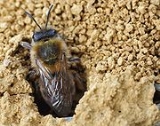
Anthophorini
Encyclopedia
The Anthophorini is a large tribe in the family Apidae
, with over 750 species worldwide that were previously classified in the family Anthophoridae; the vast majority of species are in the genera Amegilla
and Anthophora
. All species are solitary, though many nest in large aggregations. Nearly all species make nests in the soil, either in banks or in flat ground; the larvae develop in cells with waterproof linings and do not spin cocoons. Species in this tribe are often referred to as "digger bees", though this common name is sometimes applied to members of the tribe Centridini
, as well.
The characters used to define this group are subtle, but they are nonetheless fairly recognizable; they are generally large (up to 3 cm), very robust, hairy bees, with visibly protruding faces, and the apical portion of the wings are studded with microscopic papillae. The abdomen is often banded, and in many Old World
species of Amegilla
these bands are metallic blue. The wings often appear disproportionately short compared to other bees, and their "buzz" is often a high-pitched whine, as they hover and feed on flowers. Males commonly have pale white or yellow facial markings, and/or peculiarly modified leg armature and hairs.
Apidae
The Apidae are a large family of bees, comprising the common honey bees, stingless bees , carpenter bees, orchid bees, cuckoo bees, bumblebees, and various other less well-known groups...
, with over 750 species worldwide that were previously classified in the family Anthophoridae; the vast majority of species are in the genera Amegilla
Amegilla
Amegilla is a genus of bees in the tribe Anthophorini. A few species have blue metallic bands on the abdomen, and are referred to as "Blue banded bees"....
and Anthophora
Anthophora
The bee genus Anthophora is one of the largest in the family Apidae, with over 450 species worldwide in 14 different subgenera. They are most abundant and diverse in the Holarctic and African biogeographic regions. All species are solitary, though many nest in large aggregations...
. All species are solitary, though many nest in large aggregations. Nearly all species make nests in the soil, either in banks or in flat ground; the larvae develop in cells with waterproof linings and do not spin cocoons. Species in this tribe are often referred to as "digger bees", though this common name is sometimes applied to members of the tribe Centridini
Centridini
The Centridini are a tribe of large apid bees, many of which possess adaptations for carrying floral oils rather than pollen or nectar. The floral oils are often gathered from plants of the family Malpighiaceae, though other plants may be visited...
, as well.
The characters used to define this group are subtle, but they are nonetheless fairly recognizable; they are generally large (up to 3 cm), very robust, hairy bees, with visibly protruding faces, and the apical portion of the wings are studded with microscopic papillae. The abdomen is often banded, and in many Old World
Old World
The Old World consists of those parts of the world known to classical antiquity and the European Middle Ages. It is used in the context of, and contrast with, the "New World" ....
species of Amegilla
Amegilla
Amegilla is a genus of bees in the tribe Anthophorini. A few species have blue metallic bands on the abdomen, and are referred to as "Blue banded bees"....
these bands are metallic blue. The wings often appear disproportionately short compared to other bees, and their "buzz" is often a high-pitched whine, as they hover and feed on flowers. Males commonly have pale white or yellow facial markings, and/or peculiarly modified leg armature and hairs.

